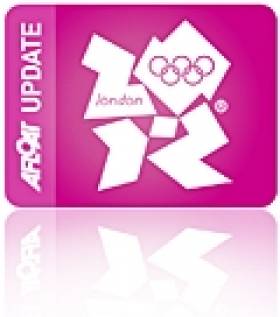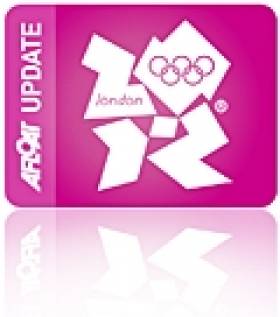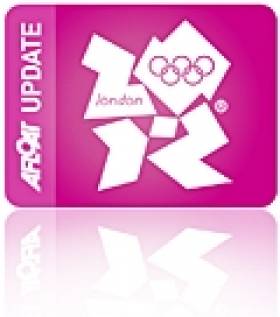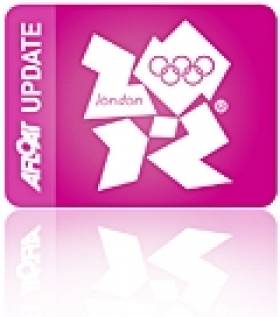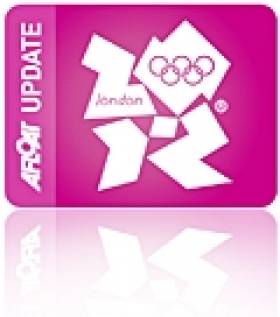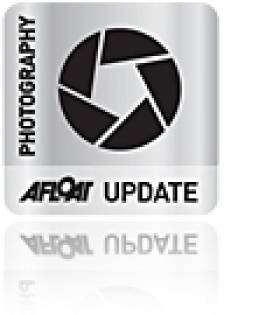Displaying items by tag: Peter O'Leary
Olympic Crews Heading for 'Sail for Gold' Regatta
After last weekend's Sailing World Cup Regatta in Medemblik, Holland the Irish Olympic sailing squad is back on the water in five days time for the next round of the Cup, this time at the 2012 Olympic venue itself and the Skandia 'Sail for Gold' Regatta in Weymouth.
Expectations are high that Ireland can be in the medals in England not least because Ireland qualifed for three medal races last week and last year Peter O'Leary won Gold in the Star class in Weymouth.
Over 1,000 sailors, including a number of World and Olympic champions, will be competing in Weymouth, Great Britain, the venue of the London 2012 Olympic Sailing Competition.
Great Britain's Ben Ainslie, Giles Scott and Ed Wright have dominated the Finn class during the 2010-2011 ISAF Sailing World Cup.
The British trio have been at the top of the podium on every occasion. Ainslie won Sail Melbourne, Trofeo S.A.R. Princess Sofia MAPFRE and the Semaine Olympique Française, Scott won US SAILING's Rolex Miami OCR and Wright won the Delta Lloyd Regatta last week.
But it is Ainslie who leads the Finn Standings on 79 points ahead of Scott, on 71, and Wright on 66. All three will sail in Weymouth alongside some equally impressive sailors in the form of the World #1 Ivan Kljakovic Gaspic (CRO), World #2 Zach Railey and Spain's Rafael Trujillo.
However it is hard to see anyone defeating the Brits who have dominated the class since the inaugural ISAF Sailing World Cup in 2008-2009 which has seen Wright crowned ISAF Sailing World Cup Finn Champion on two occasions.
Mathew Belcher and Malcolm Page (AUS) reclaimed the top spot in the Men's 470 Standings after clinching gold at the Delta Lloyd Regatta. The World #1 Australians have a 17 point lead over Panagiotis Kambouridis and Efstathios Papadopoulos (GRE) in second. World #5 sailors Pierre Leboucher and Vincent Garos (FRA) trail the Australians by 18 points in third.
The top three will all sail in Weymouth but it is a tough ask for anyone to overhaul Belcher and Page who have a strong lead with just two ISAF Sailing World Cup Regattas remaining.
Eight points separate the top five in the Women's 470 ISAF Sailing World Cup Standings.
Despite not sailing in Medemblik, Penny Clark and Katrina Hughes (GBR) retained their lead at the top of the Standings on 54 points. But Delta Lloyd Regatta runners up Ai Kondo and Wakako Tabata (JPN) trail the Brits by three points and will look to make up the ground on the World #3 pair at Skandia Sail for Gold.
Marit Bouwmeester (NED) and Evi Van Acker (BEL) are tied at the top of the Laser Radial Standings on 69 points each. They will renew their rivalry in Weymouth but with the top ten in the Standings all set to compete, and the third place Veronika Fenclova (CZE) within touching distance of the leaders the gold medal is far from a foregone conclusion.
The 2011 Skandia Sail for Gold Regatta will also welcome the top ten in the Laser Standings. The standout performer this year has been Tom Slingsby (AUS) who has been on the podium in the four ISAF Sailing World Cup Regattas he has sailed in. He has a 14 point lead over Javier Hernandez (ESP) in second and a 20 point lead over Nick Thompson (GBR) in third.
In the Paralympic classes the top three in the 2.4mR, SKUD-18 and Sonar ISAF Sailing World Cup Standings will compete.
Racing begins at the 2011 Skandia Sail for Gold on 6 June and will run until 11 June.
Olympic Results Offer Great Hope for London
Strong winds and the chance of a podium finish required more than Dutch courage for three of Ireland's top flight Olympic crews in the closing stages of the Delta Lloyd regatta at the weekend. Ireland's Star keelboat, Laser Radial and 49er sailors produced medal race results in a week where Irish crews made the headlines and all for the right reasons.
Except for two false starts for Annalise Murphy on Friday – which in all probablility cost a medal – the week ended with some stellar performances from an Irish squad of 13.
This morning to cap it all off Ireland's 49er pairing Ryan Seaton and Matt McGovern won the medal race moving them to fifth overall, their best Olympic campaign result to date. This plus the fourth overall scored in the Star Class and the Laser Radial performance that included five race wins are being held out as performances that give great hope for next year's Olympic Games regatta in Weymouth.
Royal Cork's Peter O' Leary and crew David Burrows from Malahide YC have finished fourth overall in the Star class at the Delta Lloyd Regatta in Holland which concludes today.
The regatta also doubled as an Olympic trial for Ireland and the Dublin-Cork combination have scored an important first blow against rivals Max Treacy and Anthony Shanks of the Royal St. George Yacht Club who finished 12th overall.
O'Leary and Burrows made it into the top ten for yesterday's medal race as expected and finished the Delta Lloyd regatta fourth overall, a result in the top class fleet that compares well with last year's sailnig highlight, the win at Weymouth Sail for Gold Regatta.
In the Laser Radial, sole Irish campaigner Annalise Murphy finished ninth from a fleet of 63, but regardless of qualifying for the medal race, (a feat not achieved in Palma in April), there is regret that had it not been for 'Black Friday', the 21-year old National Yacht Club dinghy sailor would have been in the medals.
In the 49er class Irish duo Ryan Seaton and Matt McGovern won this morning's 49er high performance dinghy medal race. The impressive win moves the Irish pair to fifth overall.
With six medals each, the Dutch and the Australians are claiming most medals with Holland taking four Golds in the 2.4, Women 470, Laser radial and Women Match Racing.
The first medal race saw the 49ers creating the show with the top four boats battling for the medals in windy conditions.
The wind was shifty and gusty with places changing constantly. The new Zealanders took the control of the small fleet at the first bottom mark and were in Silver medal position but a capsize after rounding the top mark again cost them the second position overall. The chase between the Australians Outteridge/Jensen and the British leaders Stevie Morrison and Ben Rhodes, was a race within the race. The Irish Ryan Seaton and Matthew McGovern won the medal race and with the Australians finishing in fourth, only two places in front of the leaders, it was not enough for them to take Gold. Morrison/Rhodes (GBR) take the Gold with the defending champions, Outteridge/Jensen in Silver and the unlucky New-Zealanders in third.
“It was tight out there, the Australians did well in the breeze. It was close racing with lots of shifts and it was important for us to avoid penalties so keep far enough but not too much.” commented Stevie Morrison soon after crossing the line.
The Finns saw a tight race and a second Gold medal for Great Britain. World Champion Ed Wright and regatta leader Ivan Kljakovic Gaspic started off with a dual between the leaders. On the run, Ed Wright sailed away and created the gap with the Croat. Wright needed to have a boat between himself and the World #1.
Pieter Jan Postma picked up some good pressure and passed Gaspic, giving at the same time the Gold medal to Ed Wrigtht who won the Medal race by a large margin. The Brit joins his compatriots, Ben Ainslie and Giles Scott on the third step of the Sailing World Cup podium.
“It was exciting to go out there this morning. I saw my friends win the 49ers and it was inspiring! I love these conditions and I was quite confident but you never know with the medal race. I van sailed really well this week and it was hard job to win this event.” declared Ed Wright (GBR).
Young Canadian Greg Douglas, have sailed today his first medal race. The 20 years old who competed in the last Olympics in the Laser for Barbados, vow that there will be more to come. “Medal race is very intense. The start was impressive with everybody 100% to take early advantage; it was tough.”
Laser and Laser radial defending champions retain their title in the 2011 Delta Lloyd regatta.
Tom Slingsby (AUS) offers a second Gold to Australians and defend his title in Medemblik. Despite a slow start into the Medal race, Slingsby caught up to speed, to finish in fourth place.
Milan Vujasinovic (CRO) won the medal race with Bruno Fontes (BRA) close behind in second.
The Brazilian conserves his silver medal and Roelof Bouwmeester (NED) Bronze.
“In australia we like wind and waves! I often perform well here. I won last year and other years as well. I like Medemblik, I feel comfortable here.”
The ISAF Sailor of the year was out of pace on the first beat but came up closer to his opponents: “I struggled to find rhythm in the shifts on the first beat but found my pace later in the race.”
A fourth place in the Medal race secured Gold for Marit Bouwmeester (NED) who retains her title.
Evi Van Acker takes her third medal in the 2011 Sailing world cup circuit. After a Bronze in the Rolex Miami OCR and a Silver in Palma; the Belgium takes Silver in Medemblik.
Xu Lija (CHN) who started the medal race in third position overall, went from leading the medal race to the 9th place, after a capsize that ended her chance for medal. A sixth place for Tina Mihelic (CRO) is enough for the Croat to take Bronze.
The podium remains unchanged in the RS:X men division after a windy medal race. Early leader Taehoon Lee displayed his strong skills in the breeze to take the medal race and his first Sailing World Cup title. First podium also for Canadian Zachary Plavsic who takes Silver. Second in Melbourne last December, Wang Aichen (CHN) takes the Bronze in the Delta Lloyd Regatta.
The wind had picked up when the RS:X women started their medal race. The strong breeze and waves proved tricky at times and provided many capsizes. Among them early leader Mayaan Davidovich (ISR) couldn't recover to finish the race and misses all chance for medal. Li Ling (CHN) who had started the day in second position, wins the Medal race by a big margin to claim the title. This is the first Sailing World Cup podium for Li Ling who placed fourth in Sail Melbourne last December.
Two Australians complete the RS:X women podium. Veteran windsurfer, Jessica Crisp is taking her third Silver medal in Medemblik. The previous ones in 2004 and 2007 were taken in the Mistral raceboard. She is six points from Allison Shreeve (AUS) who takes Bronze medal.
The 2.4 sailed a last race on Sunday. Thierry Schmitter (NED) won all the races in the series. “This has never happened to me! Of course I am really happy but not sure if it is due to my skills or the competition.” One of his main opponent, Damien Seguin (FRA) missed the Delta Lloyd regatta as he was participating in an Ocean race in Normandy.
Megan Pascoe (GBR)is taking Silver after posting a 3rd in the last race. Andre Rademaker (NED) is in 3rd overall.
Team Tunnicliffe (USA) wins the Women Match racing Petite Finale against Wang (CHN) 2-0.
The actions and drama came from the finals in the Women Match racing opposing Groeneveld (NED) and Lehtinen (FIN).
After Groeneveld (NED) won the first match with a tight finish the wind increased for the second match, a huge gust came and the Dutch boat nose dived, sending the two crew flying overboard. This was the end of the second race for the Dutch who had also ripped their jib. The Finnish won the second match and all was to be played in the last.
The wind had already increased to over 30 knots when the last decisive match started. The Finnish covered the Dutch during the first two rounds when finally the Dutch could move away and went down the run on their own. A powerful gust propelled Groeneveld team towards the finish line and allowed them to pass the Finnish a mere seconds before the line.
The Olympic sailing world is now moving to Weymouth to prepare for the 6th Sailing World Cup event, staged on the Olympic arena from the 5th to the 11th of June.
O'Leary and Burrows Widen the Gap in Medemblik
After two windy opening races and now today's two light/medium air races Holland's Delta Lloyd regatta is shaping up to be a true leg of the ISAF World Sailing Cup, an important event for 13 Irish crews competing there.
Peter O'Leary and David Burrows margin in the first Irish Star Olympic trial has increased following penalty points sustained by rivals Max Treacy and Anthony Shanks for a premature start in today's third race. O'Leary of Royal Cork is now seventh on 37 points and Treacy of Royal St. George 16th on 60 points in the ultra compettive 23-boat fleet.
After a blistering start yesterday with a 3 and a 1 in the Laser Radial Class Annalise Murphy stumbled this morning with a 37 in her 59–boat fleet. She recovered in the fourth race this afternoon picking up a ninth to be sixth overall on 51 points, some 31 points shy of leader Lithuania's Gintare Scheidt.
After scoring 10,10,21 on the first day Ryan Seaton and Matthew McGovern counted a 27 and a 7 today to be 12th overall in the 49er dinghy. Ed Bulter and Ben Lynch are 36th after falling foul of a black flag in the 39-boat fleet.
In the 470 mens fleet top Irish boat after day one, Barry McCartin and Thomas Chaix are now 53rd, Rob Lehane and Tom Mapplebeck are 48th and after an 8 and 18 today double Olympian Ger Owens crewed by Scott Flannigan jumps 12 places from 61st to 49th in a fleet of 68.
James Espey leads in 42nd leads Irish hopes in the Laser class where Chris Penney, Chris Russell and Ronan Cull are also competing in the 123-boat fleet.
In the mens heavywieght Finn dinghy, Ross Hamilton is 42nd in a 66-boat fleet.
Delta Lloyd stories:
First Blood to O'Leary and Burrows
Capsize Costs Annalise the Lead
All our Olympic Sailing Coverage here.
Day 2 report:
After a windy opening day, the Delta Lloyd regatta provided sailors with challenging conditions with shifty winds on day two of the fifth ISAF Sailing World Cup event."Olympic couple" Robert and Gintare Scheidt, racing in the Star and the Laser Radial are leading their class with top results including a win in the last race. At the end of the day they Match-raced each others in the "fun race" organised for the day winners. Robert took the win but Gintare is aiming to take her revenge before the end of the week!
The Stars were last off the water last night, with their fourth race ending at 9.30 PM! Beijing Silver medallists, Robert Scheidt and Bruno Prada (BRA) took the early lead with a third and a win, followed by another win in today's last race. They are continuing on their good form after winning the Semaine Olympique Française in Hyères with a day to spare. After a victory in their last event in Palma, Iain Percy and Andrew Simpson (GBR) are in second position and in contention for the event title. Canadians Richard Clarke and Tyler Bjorn, and last year SWC winners Eivind Melleby and Petter Moerland Pedersen (NOR) are only one point from second.
Beijing Silver medallist Gintare Scheidt (LTU) is climbing to first place in the Laser radial after mastering the day's tricky conditions. "The wind was very shifty and the positions changed constantly throughout the races." Tina Mihelic (CRO) who is still carrying a disqualification from the first day won the first race and placed fourth in the second. She is in tenth overall. "It was a difficult day with big shifts but I sailed well. I look forward more races to discard my OCS and come up in the rankings."
Early leader Marit Bouwmeester (NED) lost seven places after a difficult day. She comments on her 39th with: "On the first race I got carried away, too eager, I went too far left and ended up with less wind." Bouwmeester compared today's conditions with the ones encountered in Weymouth when the northerly is blowing.
Milan Vujasinovic (CRO) conserves the lead in the Laser on equal points with Bruno Fontes from Brazil. "I am happy with today's results and to keep the lead." says the Croat, "Light winds are not my favoured conditions, and I found it really hard! I just had to be patient and wait to benefit from the situations that came my way."
In the RS:X, Palma's winner Dorian van Rijsselberge (NED) takes the lead from JP Tobin (NZL) after consistent sailing. "I have not seen conditions so unstable, the wind went right and left and up and down. In the second race I ended up in a hole in the middle and rounded the top mark in 30th position. These conditions also gave me opportunities to catch up and finally finish fifth!" explains the Dutch.
2010 Asian Games champion, Wang Aichen (CHN) wins the second race and places in sixth position overall.
In the Women division, Mayaan Davidovich (ISR) who placed 9th in the Delta lloyd regatta last year is taking the lead with consistent results. Jessica Crisp (AUS) is following closely after winning the first race of the day. The Chinese sailors are once again proving their strong abilities in windsurfing claiming, third, fourth and fifth places.
Olympic medallist Fernanda Oliveira with new crew Ana Luiza Barbachan (BRA) have taken the lead in the 470 after top three results in today's tricky conditions. Yuka Yoshisako and Noriko Okuma (JAP), 5th at the 470 Spring Cup are taking second position overall. After mixed results (19th and 1st), early leaders Martine Grael and Isabel Swan (BRA) are in third in front of Dutch team of Lisa Westerhof and Lobke Berkhout who have collected near perfect results with a first and a second.
In the Men division, Sime Fantela and Igor Marenic (CRO) are conserving their lead, three points over World # 1 Mat Belcher and Malcolm Page (AUS). The day went to the Japanese teams with Tetsuya Matsunaga / Kimihiko Imamura and Ichino Naoki/Ryouhei Froyliche enjoying the conditions with a second and a first each. "We like the light conditions so today was a day for us." explains Tetsuya, "We were in the lead at the top mark but got passed by Ichino and Ryouhei. We beat them again downwind." The Japanese 470 has a strong team in Medemblik. "We are five boats training together and progressing together as well." Tetsuya and Kimihiko, after finishing 18th in Medemblik in previous years, have an objective of top three in this event.
Finn World Champion Ed Wright (GBR) is increasing his lead in the Finn fleet after winning a second race today. Ivan Kljakovic Gaspic (CRO) is second, ten points from Laser Olympic medallist, Slovenian Vasilij Zbogar. The second race in the Finn penalised eight boats over the line. Among them, Dan Slater (NZL) is collecting his second penalty.
In the 49er, yesterday leaders, the Australians Outteridge/Jensen and the Philips brothers, got disqualified by the jury for rounding the wrong mark. Stevie Morrison and Ben Rhodes (GBR) are taking the lead with Peter Kruger Andersen and Nicolai Thorsell (DEN) in second and the Australians Outteridge/Jensen third.
The qualification stage in the Women Match racing is nearly completed. In Group A, Tamara Echegoyen (ESP) and team have continued on their perfect racing with eight wins and will enter the Gold group undefeated. Team Tunnicliffe (USA) have had a better day with four wins and are second in the Gold. Second spanish team of Roca is taking the third place in the Gold from Group A. There are still some matches to be raced in Group B, Groeneveld (NED) and Skudina (RUS) have both collected 6 victories. Racing will resume in the morning to decide the three teams qualified in the Gold fleet.
"The matches have been really hard and a real contest so we are happy with our results. We are in the Gold group thanks to real team work. Yesterday, in the breeze every small mistake could cost a lot and we needed to be careful. Today the wind was hard to read and my crew did a great work with the strategies. We needed to be very attentive to the wind shifts." explained Tamara Echegoyen (ESP).
Thierry Schmitter (NED) and Megan Pascoe (GBR) are continuing with their series of first and second places and increase their margin over the rest of the fleet.
Thursday will be the last chances for classes racing in groups to qualify for the Gold fleet.
Irish Olympic Keelboat Trials Starts this Month
Act one, scene one of Irish sailing's bid for Olympic glory in London next years kicks off this month when rival helmsmen Max Treacy and Peter O'Leary square up for the right to represent Ireland next July at the Olympic Regatta in Weymouth.
The Irish Star keelboat Olympic trials gets underway on May 24th on the waters off Medemblik, Holland as part of the massive ISAF Delta Lloyd regatta.
O'Leary with new crew (and triple Olympian) David Burrows will go head to head with Treacy and Anthony Shanks in a 23-boat fleet that has attracted all the top teams, a mirror of next year's Olympic regatta itself.
The two Irish boats haven't met since last August when O'Leary sensationally won Britain's Sail for Gold Olympic test event at Weymouth and Treacy withdrew with boat problems.
Since then O'Leary and Burrows have been training in the USA scoring a significant second overall at the Bacardi Cup in February.
Treacy and Shanks have proved a formidable combination clocking up some impressive results over a decade or so in the Star class competing first for a place for Athens 2004, then Beijing and now London. It is understood the pair are hooking up next week with long time training partner (and British Olympic Gold medalist) Ian Percy for an intensive two week training session.
While the first of the nomination trials is to be held in Holland, the second is in July in Weymouth but it's worth remembering the first chance of nation qualification – where 75% of Olympic slots are up for grabs – is not until December in Perth, Australia.
The new procedures set out for Olympic qualification were announced by the Irish Sailing Association in January.
The memory of the selection debacle from four years ago is still very much in mind. Back in 2008 a decision to send O'Leary instead of Treacy was made by an ISA selection committee rather than on the water trials, a move that was unsuccessfully appealed by Treacy to the Olympic Council of Ireland (OCI). It was a divisive period for Olympic sailing in Ireland.
Confirmation this week that both teams are entered for the Delta Lloyd regatta in Holland and both boats are also entered for Perth indicates the stage is set for the next episode of Star wars.
The sailing season is starting and selecting the Afloat.ie/Irish Independent "Sailors of the Month" for March has been a swift business, with the remarkable performance by Peter O'Leary of Cork and David Burrows of Malahide in the Olympic Star Class's legendary annual Bacardi Cup series in Miami emerging as the clear winner.
Admittedly the Irish duo only managed the runner-up slot in Florida. But in a fleet of 93 boats rampaging around in wildly varying conditions, it was an achievement to be at the top of the frame at all. And they were beaten by only one point, even if it was lost in the final race, which they'd started leading overall by a point.
Because the Stars are under a death sentence in the Olympic scene, with next year's Olympiad their final appearance in the five ring circus, the class has acquired an extra slightly morbid interest. And the boat tuning and tweaking knowledge acquired during their long Olympic career will see the class's measurement and equipment rules pushed to the uttermost for this last hurrah.
In fact, some Star fans have become emotional and compared the showdown to a combination of the OK Corral, the Alamo, and Custer's Last Stand in light of the Star's American origins, while the more internationally and nautically minded have invoked memories of Trafalgar and Lepanto.
And all this for one of the oddest looking and most demanding boats on the planet. The Olympic glow does that to people. This time round, we happily glow ourselves, as the O'Leary-Burrows team (each has figured as Sailor of the Month before, but this is their first time together) and the combinations shows every promise of having what it takes.
Irish Olympic Crews in Top Twenty of World Rankings
Peter O'Leary who has been sailing with three different crews, David Burrows, Frithjof Kleen and Timothy Goodbody to date is ranked 17th by the International Sailing Federation (ISAF).
O'Leary and Burrows sailing in the Star keelboat class were recent top finishers at 93-boat fleet in Miami. They finished second overall after they lost the overall lead in the last race of the 2011 Bacardi Cup.
Listen into a podcast about Peter O'Leary's Olympic sailing plans HERE.
Fellow Olympic squad member, 21-year old Annalise Murphy from Dun Laoghaire is now ranked 12th in the Laser radial class counting seven ISAF events. Murphy has also had success in Florida this season, she finished fourth in the Miami Olympic Classes regatta in January.
Listen to what Team Manager James O'Callaghan has to say about her progress:
The next release of the ISAF World Sailing Rankings will be on 13 April 2011 and will include the Trofeo SAR Princess Sofia Mapfre in Spain.
The ISAF World Sailing Rankings rate skippers based on their performances over the last two years. Skippers score points by competing in ISAF Graded events. The top finishers at all ISAF Graded events score Rankings points, with the highest points awarded to the event winner and then decreasing down relative to position.
More Irish Olympic Sailing News HERE.
O'Leary and Burrows Pipped by Single Point for Bacardi Honours
France's Guillaume Florent and Pascal Rambeau accomplished a rare achievement in Saturday's finale of the 84th event Cup.
Florent, the 2008 Olympic bronze medalist in the Finn class who switched over to Star keelboat last year, won the prestigious regatta at his first attempt.
O'Leary and Burrow's second overall in the 93-boat fleet is being hailed as a major result for the pair who have sights firmly set on selection for the London 2012 Olympic Games.
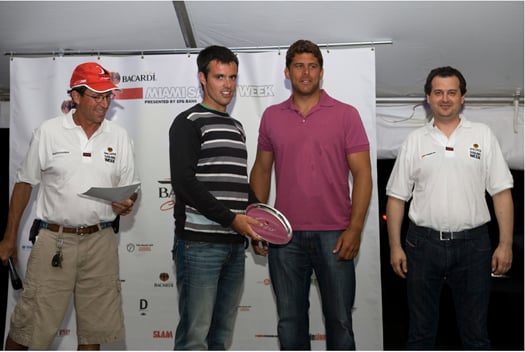
Peter O'Leary and David Burrows (centre) receive the Bacardi Cup second place salver in Miami yesterday. Photo: Courtesy Bacardi Cup/Star Class
Their final score after six races that began on Monday was 24 — only one point behind the French duo.
In a consistent display of speed and tactical ability against a big international fleet only Ireland posted the most consistent scores of the series with all results in the top ten.
Racing in the event was cut short due to thunderstorms on Thursday.
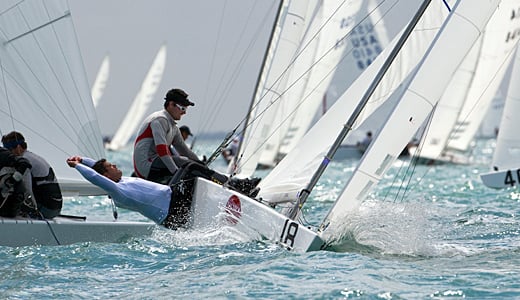
Peter O'Leary with crew David Burrows at full stretch at the weather mark. Photo courtesy Bacardi Cup
O'Leary and Burrows recorded single-digit finishes over the course of the regatta; they finished with an 8-4 on the penultimate day to move from fourth overall into the lead of the 89-boat fleet with 18 points only to lose out in the final race.
Full Results HERE.
Star Class website/results/comment HERE
Photos of O'Leary and Burrows in action on our gallery HERE
Podcast interview and Career highlights of Peter O'Leary HERE
O'Leary and Burrows Stay Fourth at Bacardi
O'Leary and Burrows Lie Fourth at Bacardi Cup
Peter O'Leary and David Burrows lie fourth overall at the halfway stage of the Star class Bacardi Cup in Miami today having posted a 7, 2 and 5 in the 93-boat fleet. Promisingly for the Cork-Dublin duo their top results have also been achieved across the wind range, a fact that must bode well for the remaining three races of the series on Biscayne Bay. Full Results HERE. A podcast with Olympic team manager James O'Callaghan is below:
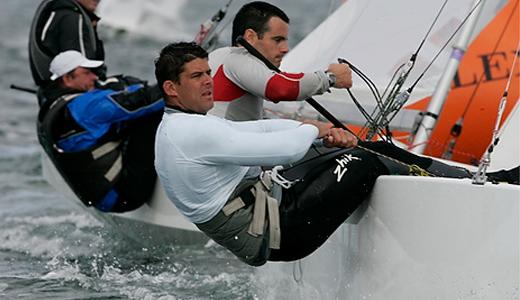
Peter O'Leary and David Burrows - fourth at the half way stage of the Bacardi Cup. Photo: Ingrid Abery. More HERE






























